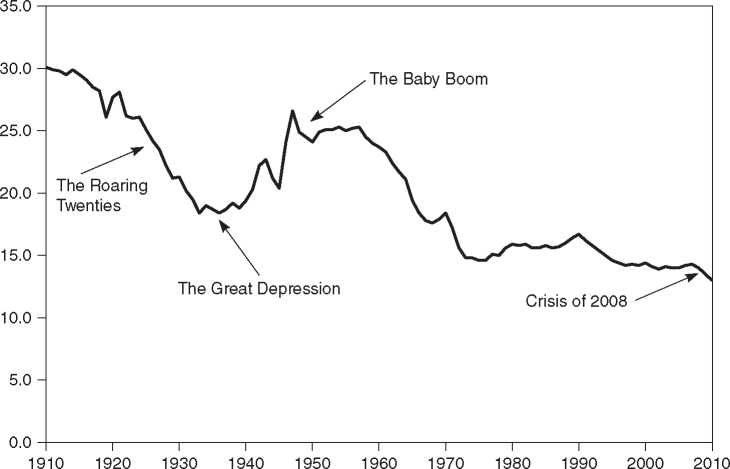The birth rate plunged during the Great Depression. For women between the ages of 15 and 44, the prime child-bearing years, the rate fell from 89 births per 1,000 women in 1929 to a low of 76 in 1936. With the return of prosperity during World War II, the rate increased. In 1942, the birth rate reached 92, surpassing 1929, although the birth rate fell in 1944 and 1945.
In 1946, the baby boom began. Undoubtedly, the baby boom owed part of its existence in its early years to the reuniting of couples separated by war, but it continued long beyond the time when this romantic story was an important factor. The baby boom, as shown in Figure 29.2, lasted until the late 1950s. The birth rate then plunged to historically low levels. Indeed, natural fertility rates were so low that in the absence of immigration, the population might have declined. The child dependency ratio (the ratio of children under 14 to women between 20 and 54) peaked a few years after the baby boom began to taper off.
The baby boom was a complex phenomenon. Perhaps the most important economic factor was the expectations that people had about future economic conditions. The 1950s were the economic reverse of the 1930s: A strong economy and optimism about the
FIGURE 29.2
The Crude Birth Rate (number of live births per 1000 people), 1910-2010.

Note: Economic forces, such as the business cycle, have had a major impact on the birth rate.
Source: Historical Statistics of the United States Colonial Times, millennial edition, Series Ab40; Statistical Abstract of the United States, various issues.
Future encouraged Americans to start or enlarge families. The birth rate declined for a number of reasons. Again, the rise in uncertainty about the future that prevailed in the 1960s and 1970s, like the uncertainty that prevailed in the 1930s, discouraged family formation and child bearing. The fall in the birth rate was also related, as shown in Figure 29.2, to the increasingly frequent decision by women to enter the paid labor force. Access to highly effective oral contraceptives, beginning in the 1960s, also contributed to the reduction in the birth rate (Goldin and Katz 2002, Bailey 2010).




 World History
World History









